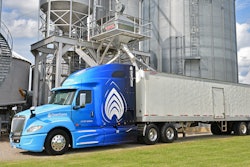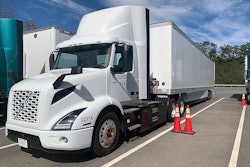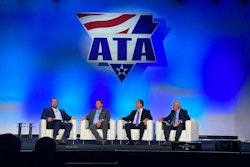Driving 600 miles a day in a diesel truck is a great way to appreciate truckers.
A few lessons I learned along a 2,530 mile five day trip:
• All roads are not smooth
• There is more than a fair share of distracted drivers out there to maneuver around
• Relentless wind noise and road noise is physically taxing over 11 hours per day
• I don’t think you can pay enough for a good driver’s seat or passenger seat
• Truck stops are not all sized for 200 tractor trailers. Some barely fit a handful
• The staff at truck stops, probably some of the few people a driver interacts with face-to-face, really help break up the endless miles with smiles
• Diesel and DEF pump on the left side of the truck. My truck had the DEF tank on the right for some reason that I have yet to figure out.
Let’s talk about geography. I am very positive on zero-emission battery electric vehicles (BEVs). My first report for NACFE on BEVs was titled, Battery Electric Trucks – Where They Make Sense. I was quick to note that BEVs are not the solution to replace every diesel truck out there. Shorter urban and regional haul routes with return-to-base daily operations are ideal for BEVs as NACFE wrote in our Run on Less Electric market segment reports Electric Trucks Have Arrived – The Use Case for Heavy-Duty Regional Haul Tractors and Electric Trucks Have Arrived – The Use Case for Medium-Duty Box Trucks.
After my trek across the western U.S., I am even more convinced that there are quite a few routes where BEVs are simply not going to be the right solution. Take Henderson, Nevada to Boise, Idaho. I did.
There is quite a long stretch of beautiful nothing; no truck stops, no cities, almost no indication of human civilization except for the road. There are stretches of road with no Wi-Fi connection. I drove for 639 miles with very little services and few places to even pull off the road.
Eastern Oregon is somewhat better, but Boise to Portland has some fairly sparse regions as well. New Mexico and Arizona are similarly not very densely populated and infrastructure is going to be a serious challenge for battery electric trucks between cities.
In and around the cities, there are many opportunities for the electrification of trucking to take hold and provide positive returns. I was impressed with seeing very large wind farms and solar farms on my trip across western America. Outside Boulder City, Nevada, right near Hoover Dam, are some massive solar farms. The diversity of energy powering southern Nevada is impressive. Just north of Las Vegas is another very large solar farm making use of the desert. Wind farms were all over western Texas, eastern Oregon, and isolated places in between. I believe there are a lot of opportunities for wind in the western U.S.
Converting truck stops is another topic area on my BEV list of subjects. There are several I noticed that have added Tesla electric car charging stations. Forward thinking truck stop operators have managed to get increased electric power to their facilities without significant disruption to their operations. However, there are many small truck stops, ones with a handful of pump islands and just enough room to turn a few trucks around.
The local geography really is not suited to having a Texas size 200 plus truck parking area and 20 fuel islands. These smaller truck stops have to wrestle with adding propane, CNG/RNG, hydrogen, electricity, etc., and just do not have the real estate to diversify. Look at a satellite image of Biggs Junction, Oregon, to see a few examples.
Interviews I’ve had with young and old drivers who have experience with BEVs all are glowingly positive about the experience. They are quiet, don’t smell, have no fumes, and diesel or DEF spills on clothes are absent. There is no walking through puddles of unknown composition at the fuel islands. All dead accurate issues from my limited sampling of nine truck stops and a five-day drive.
However, the noise engineer in me has to point out that regardless of powertrain, wind and tire noise are the primary sources of sound in the truck cab at highway speeds. Electric vehicles, diesel vehicles and CNG/RNG vehicles all can suffer from poorly fitting door seals or particularly noisy tire choices. Squeaks and rattles are going to be more noticeable in BEVs at the lower speeds because of the quieter BEV powertrain, but wind and tires always will predominate at the higher speeds.
Driving trucks is physically demanding. Doing it day after day and mile after mile is hard on drivers’ bodies. Whether a BEV or ICE powertrain, you just can’t have a good enough seat. BEVs inherently do not have an advantage when it comes to bouncing down the road. A warning to truck manufacturers looking to shave a few dollars off of existing truck systems like seats in order to offset increased costs for the BEV power systems: don’t. Driver retention always has been challenging. Investing in a good — or rather, great — seat system seems like a priority for any fleet or manufacturer.
I’ve always been an advocate for training OEM engineers to really experience the environments they design into. Spending time on the production line in a truck factory seems to be a requisite starting point for any engineer. Combine that with spending a week driving a truck cross country, and then a week driving another in an urban route. It always amazes me that desk-based engineers and researchers always seem to just know what the right solutions are for truckers, having never experienced the trucker’s day. Many times, these desk-bound experts are just out to lunch. Don’t be afraid to get some field experience before concluding that your new concept is the next best thing for trucking since tires.
My hat is off to those who drive 600 miles a day, five days a week. We don’t pay them enough for what they do to get us our materials.










